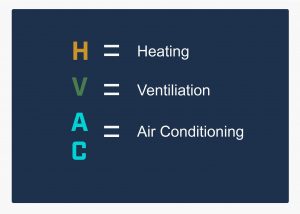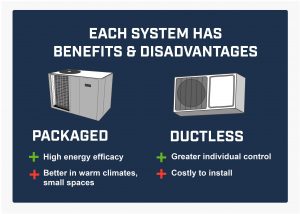
Heating and cooling terminology can be confusing to most people, especially when trying to decide on a new HVAC system for your Beaverton business or residence. Do you own a home or commercial property and want to learn more about HVAC basics? Our NATE-Certified technicians share the 17 most common terms you should know before purchasing.
Local HVAC Contractors in Beaverton Explain Heating and Cooling Basics
 Before you decide to buy a new air conditioning and heating system for your property, it’s essential to understand some fundamentals. Our HVAC contractors are often asked, “What is an HVAC system?” and “What do I need to know before I purchase one?”
Before you decide to buy a new air conditioning and heating system for your property, it’s essential to understand some fundamentals. Our HVAC contractors are often asked, “What is an HVAC system?” and “What do I need to know before I purchase one?”
Simply put, HVAC stands for “heating, ventilation, and air conditioning.” These complex machines are tasked with performing all your heating and cooling needs. When researching options, you will discover a wealth of different types, various energy ratings, and technical terminology. Our expert sales and installation team has compiled must-know terms to help you make informed decisions. Read on for more details.
3 Common Types of Commercial and Residential HVAC Systems
- Ductless Mini-Split System: Ductless systems, as the name suggests, do not require full-sized duct systems to function. They are often individual units, installed in each room, which allow homeowners, business managers, and tenants to control temperatures by room instead of the entire building.

- Packaged System: A packaged system is like an all-in-one HVAC unit where the heating, ventilation, and cooling components are all contained within a single housing.
- Split System: Split systems are the most common HVAC units. These HVAC units have a unit dedicated to cooling and another for heating. The air conditioning components are typically located outdoors, whereas the heating elements are inside the building.
Each type of system has its benefits and its disadvantages. Ductless models allow for greater individual control, but can be costly to install. Packed systems tend to work better in warmer climates and small spaces, but offer high energy efficacy. Our HVAC sales and service team in Beaverton can help you make the right choice for your commercial property or private residence.
10 Heating and Cooling Terms
- Air Conditioner: Residential air conditioners and commercial cooling systems pull heat from inside your building and force it outdoors to regulate your indoor comfort levels. Many Beaverton homes tend to install split-system units. However, you will find air conditioning units in every type of unit.
- Air Ducts: Air ducts are pipes or tubing that distribute warm or cool air throughout your property, depending on your comfort needs. They are often located in attics, behind walls, or in the ceiling.
- Condenser Coil: Condenser coils are housed inside your air conditioning or heat pump. An external fan blows air from the outside while the refrigerant disperses throughout the coil.
- Dampers: A damper is a mechanism that regulates airflow through your home or commercial building. You will find them in the floors and ceilings, and they come in two forms: manual and motorized.
- Ductwork: When someone refers to commercial and residential ductwork, they are talking about the integrated system of air ducts and dampers.
- Evaporator Coil: Located inside your furnace, evaporator coils are responsible for cooling your indoor air. Refrigerant cycles through the coil, cooling down the surrounding warm air. This chilled air is then forced through the ductwork system.
- Furnace: Furnaces are designed to warm air and distribute it throughout the duct system to achieve your ideal indoor temperature. Whether your furnace is manufactured for home or commercial use, all units contain:
- Burners that burn and disperse fuel
- Heat exchangers, which convert cold air to warm air
- Blower to help distribute the warmed air
- Exhaust flue to remove by-products
- Heat Pump: Heat pumps provide both heating and cooling by drawing in outside air to achieve ideal temperatures.
- Indoor Air Quality: Indoor air quality (IAQ) refers to the levels of pollution inside your home or office, which stem from various sources, including foreign contaminants, mold, mildew, and pollen.
- Thermostat: Thermostats can be found in manual, programmable, and smart models. They are responsible for controlling your preferred indoor temperature.
4 Heating and Air Conditioning Efficiency Labels
- AFUE: Furnaces are rated according to the Annual Fuel Utilization Efficiency (AFUE) ratio. This ratio measures a furnace’s capability of transforming heat into energy. The higher the percentage, the more energy-efficient the furnace.
- EER: Energy Efficiency Ratio (EER) is a measurement used by HVAC contractors and manufacturers to calculate an air conditioning unit and heat pump’s overall energy efficiency. The calculation is based on a 100% cooling load, 50% humidity, and temperature range of 95F to 80F.
- HSPF: Heating Seasonal Performance Factor (HSPF) is a rating system used to gauge a heat pump’s level of efficiency.
- SEER: Seasonal Energy Efficiency Ratio (SEER) measures heating and cooling energy efficiency levels. These ratings are based on the average cooling output taken during the summer months.
Commercial and Residential HVAC Contractors for Your Beaverton Home or Business
Before you decide on your new heating and cooling purchase, let our team of expert contractors at AAA Heating and Cooling help. With over 50 years of serving the Beaverton and Portland metro area, we understand our clients’ unique needs and provide professional solutions. Our skilled technicians guarantee expert installation and quality repair. Contact us today!